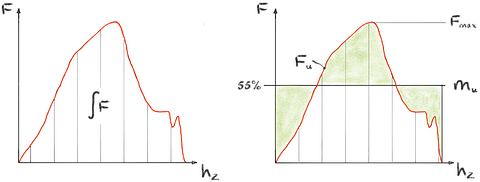Forming work deep drawing

Both the blankholderforce Fnh and the forming force FU must be applied. The deep-drawing and hold-down work is obtained from the integral below the respective force-displacement curve.
A simplified determination of the forming work can be achieved by using the mean value theorem of the integral calculus.
To determine the drawing work, the maximum occurring drawing force Fmax is multiplied by the mean value factor mU and the drawing height hZ. This results in the punch or forming work. Typical mean factors in deep drawing are:
Average factor blankholderforce mnh = 0.95
If the blankholderforce is set to be constant, the mean factor is significantly higher than the mean factor of the punch force. Even if the blank holder force is less than the maximum punch force, the hold-down work is often higher than the punch work due to the higher averaging factor.
The mean factors of different stamping processes vary. See table Mean Factors.